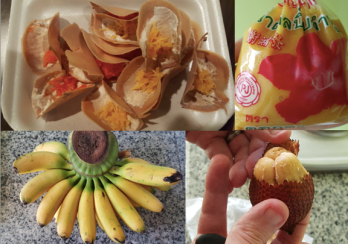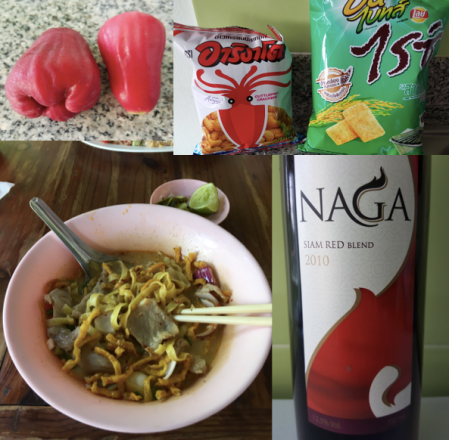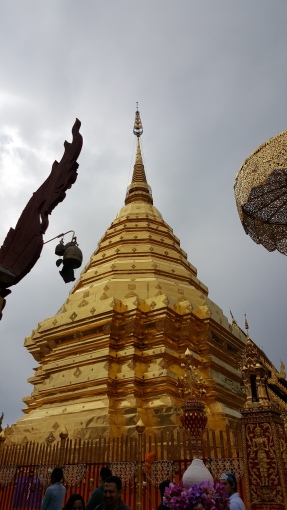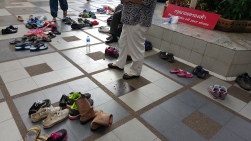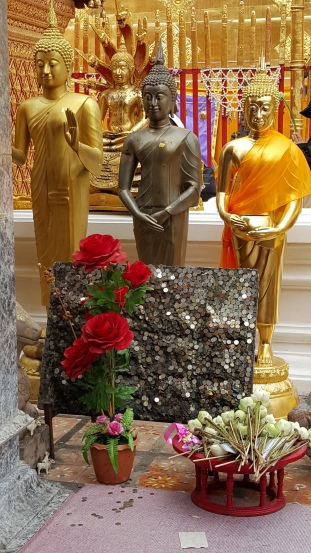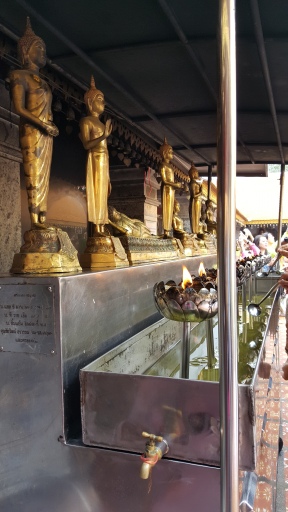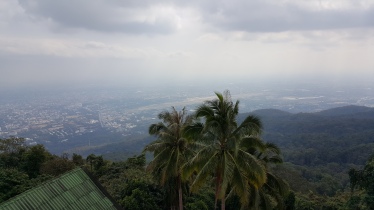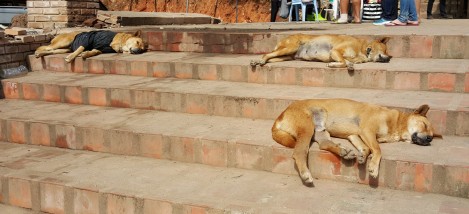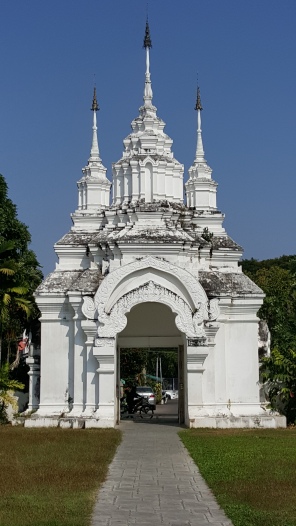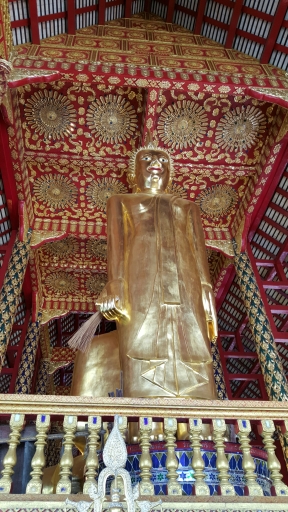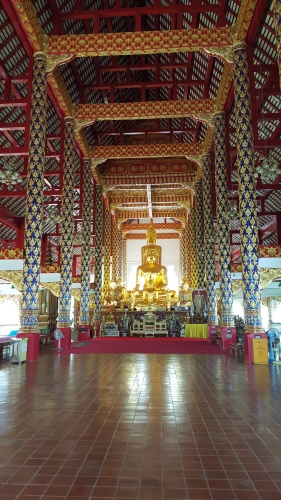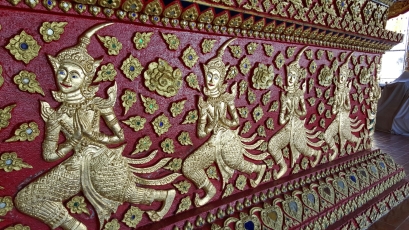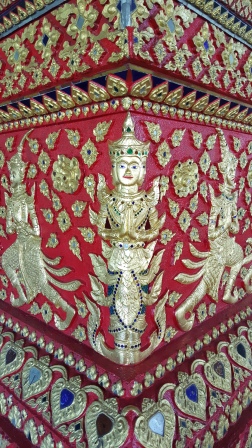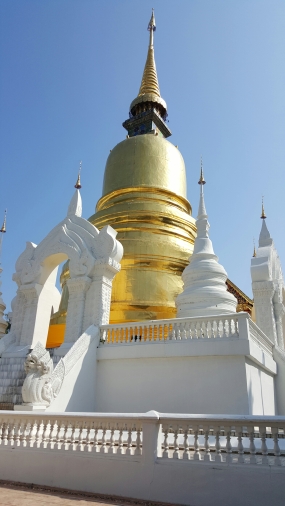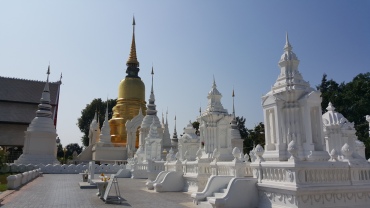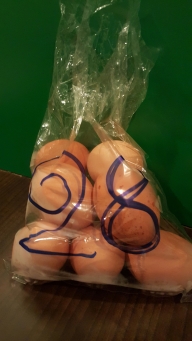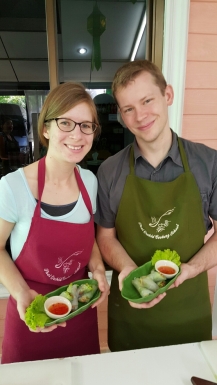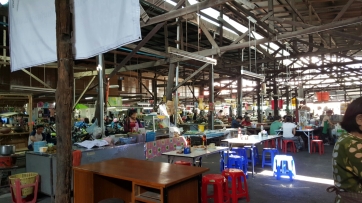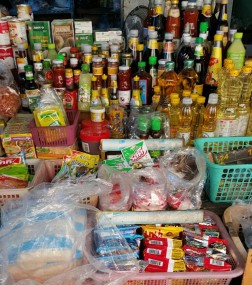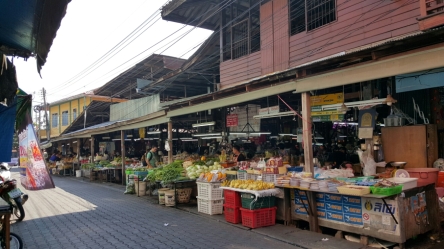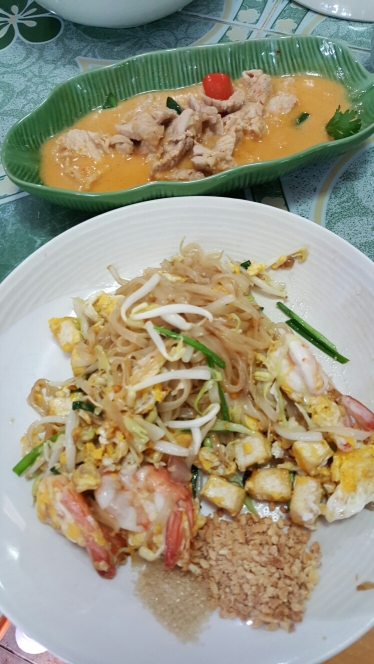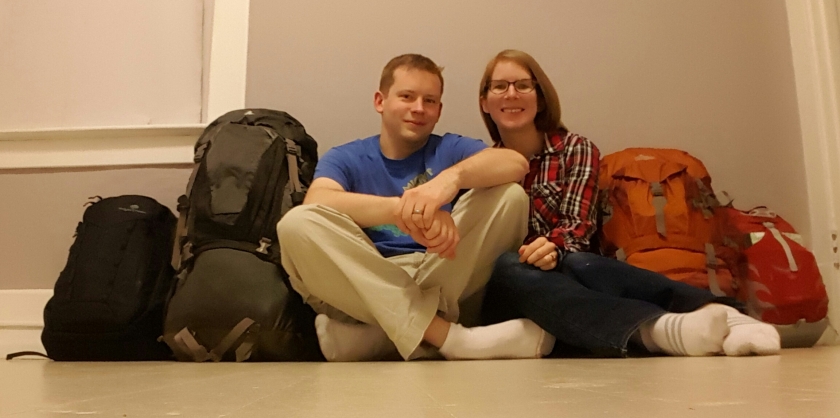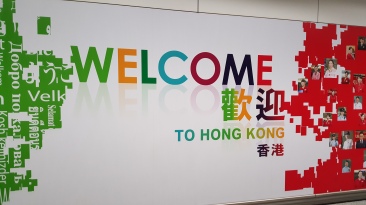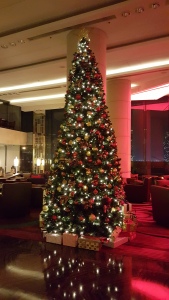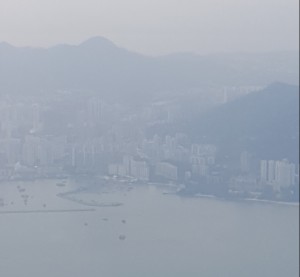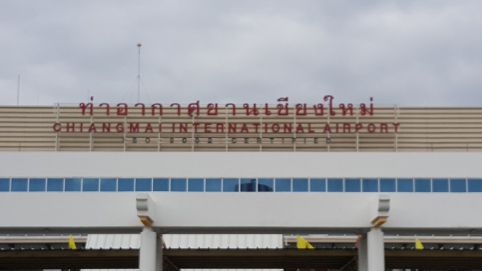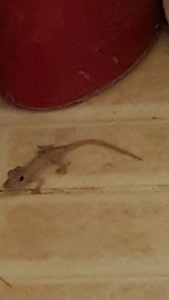We’ve been in Chiang Mai almost two weeks, and are enjoying the relaxed pace. We generally wander around the city and sightsee in the morning and then head indoors during the hotter afternoon hours and head out again for some local eats at night.
Here is what we do for a lot of the day-to-day basics that people were asking questions about before we left:
Getting around: We walk because that is what we do. Here it is a bit more like hiking – sidewalks are usually narrow and uneven and are often filled with vendors (street food and otherwise, making it hard to go anywhere without wanting to sample barbecued fish, fried chicken, waffles, or fresh fruit), sleeping dogs, parked motorbikes, signs, trees, and electrical wires. Crosswalks are rare, so often we just do what everyone else does: watch for a gap in traffic, try to take into account motorbikes that appear from nowhere, and dart across to the other side. We can catch a red truck back to our apartment for about 60 baht ($2) from anywhere in the old city if we don’t feel like making the return on foot.
Cell phones: It took less than 15 minutes to walk into a DTAC store and equip our phones with local SIMs loaded with enough talk time and internet access for the month.
Water: What comes out of the faucet can be used for doing the dishes and brushing teeth. We drink and cook with bottled water, as locals do. Our apartment came with a case of water, but when we used the last of that yesterday we gathered up the bottles and spare change and went to the nearest bookcase-sized machine that sells filtered and purified water. On our street there are about half a dozen of them, and they charge a couple of cents per liter. I haven’t yet mastered the ability to switch out bottles while the water is still running; my skirt spent the afternoon drying in the window.
Laundry: Often paired with water machines are washers (and machines to allow you to top-up your calling cards and phone plans). The washers are fancier than what we had at our apartment in Seattle – we get to choose from many more settings, some a mystery. Mostly just flip the switch, hit start, and go. The previous person wanted their clothes to come out clean, so this load probably will too.
Fresh fruit & veggies: Just wander down the street and buy what you need! Dozens of vendors are in every direction, and in markets greengrocers are conveniently grouped together, making it easy to compare prices and selection.
Packaged food & meats: Head to any number of grocery stores, from the 5 small & locally run ones on our street or to chains like 7-Eleven and Tops. Snack foods are big, so chips and crunchy treats are for sale practically everywhere. But wine, dairy (especially cheese and milk), western-style bread, and cereal are harder to find and as or more expensive than in the U.S. The food I miss most is large quantities of chocolate. Candy bars are sold at most grocery stores, but are imported and relatively expensive. They don’t hold up well in the summer (or winter) heat and there are other local sweet treats to try. Still, chocolate was a big part of my diet and the single-candy-bar-every-couple-of-days approach leaves me wanting more.
Meals: We sometimes cook breakfast at home (eggs), but other meals are cheaper out. Especially if you are looking for pad thai or common cuisine like fried rice or khao soi, just go to a street kitchen. The typical one has a hole-in-the-wall feel – 8 or 10 tables, plastic chairs, and a picture menu hung on the wall or on the sign out front (though many also have laminated menus in Thai and English); food is made with the produce and meat on display in the front of the restaurant. The best food we’ve eaten here (and there has been a lot of it) has all come from these restaurants.
Entertainment: Wandering around the city is about all you need – there are Wats, open-air markets, shops, and restaurants everywhere. Our cable has two English channels – one German and one Japanese, both with a thankfully small amount of US election coverage. But we also (clearly) have the internet and access to it is fast and cheap.
Language barrier: Hellos and thank yous in Thai and smiles seem to get most points across, as do polite pointing and questioning looks. Most salespeople are able to quote prices in English or written Arabic numerals; if they are unsure, they just pull out a calculator. I learned to count to a hundred in Thai today in hopes of making markets simpler.
Ants: Everywhere we’ve been in the tropics has ants (I’m looking at you Hawaii), and Thailand is no exception. Even on the third floor, the tiny critters find their way inside (leaving out a plate with the remnants of barbecued chicken was not the best idea, though it sat on the table for less than an hour). We keep things in the fridge as much as possible, wash the few dishes we have immediately, and use this wonderful ant-slaying chalk that is apparently illegal in the US (because kids). Just chalk up a corner or sill and the ants drop in itty-bitty heaps on the floor.
How to pay for stuff: It is generally expected that cash will be used for transactions; we paid for our apartment in advance, so most of what we buy costs relatively little. ATMs that willingly take U.S. cards are everywhere, so we get a few days worth of baht and then break the larger bills at grocery stores and use the change for meals at smaller restaurants or for individual items from the market. The most useful denomination is 20 baht (the smallest bill) – most meals and cab fares are priced in multiples of this. The 1-10 baht coins are saved for laundry and filling water jugs.
In general: Chiang Mai wakes up slowly in the morning and comes alive in the evening when people go out to eat and see friends and neighbors. In the morning our corner of the city wakes up to planes, the local dog pack, and bird and insect calls. We catch whiffs of tropical jungle coming through the windows. That scent can be replaced by exhaust (like in any city) and sometimes by a sewery odor (while sewers are covered, run-off drains are not always and these are used often used for dishwater and water from street and floor cleaning). Chiang Mai is a very international city, and that makes it easy to navigate, fit in, find people to talk to (even to see Star Wars in English on opening weekend), and find places that remind us of home (Beer Lab carries Deschutes and Rouge beers and we’ve seen Snoqualmie wine from Washington for sale).
